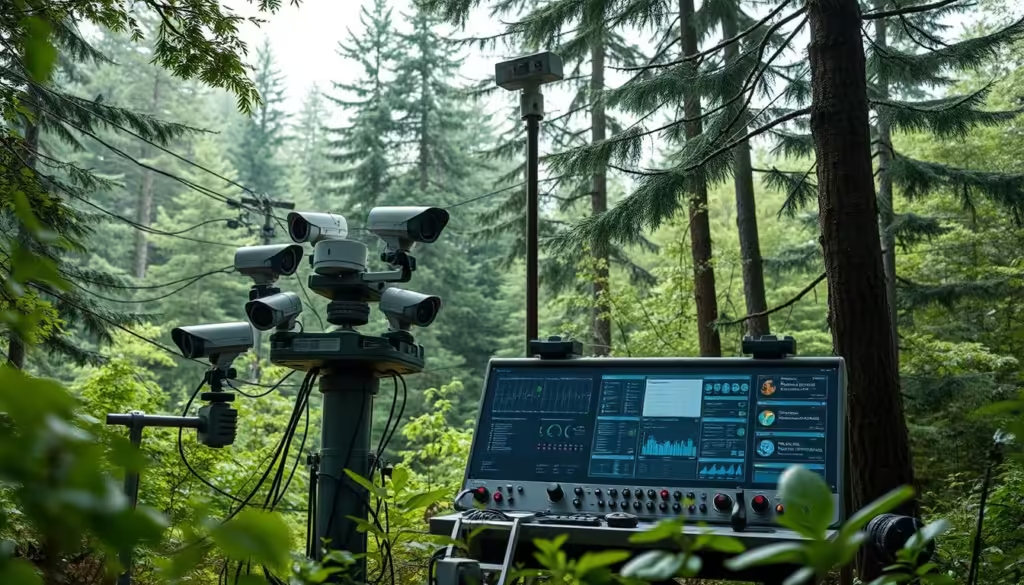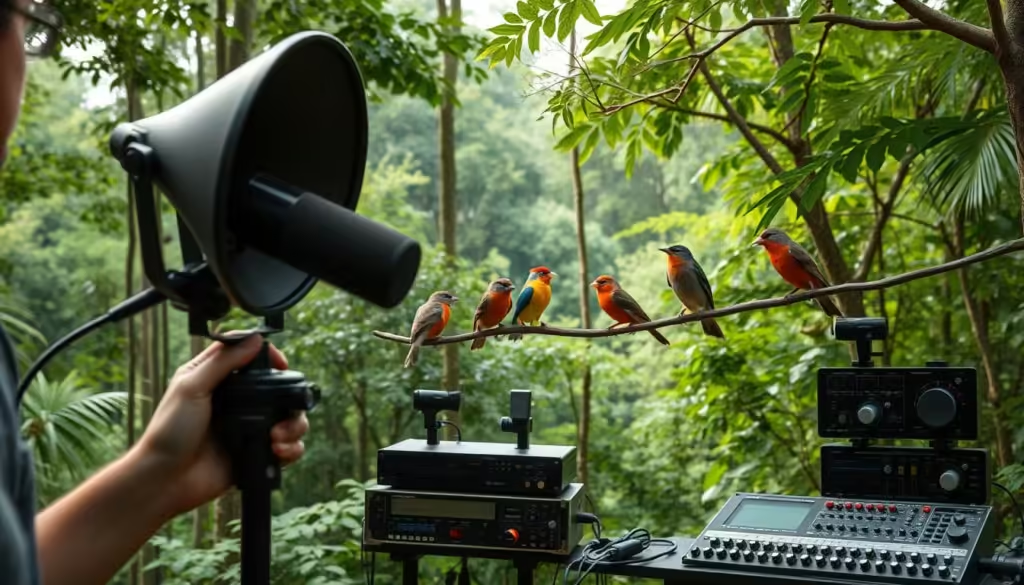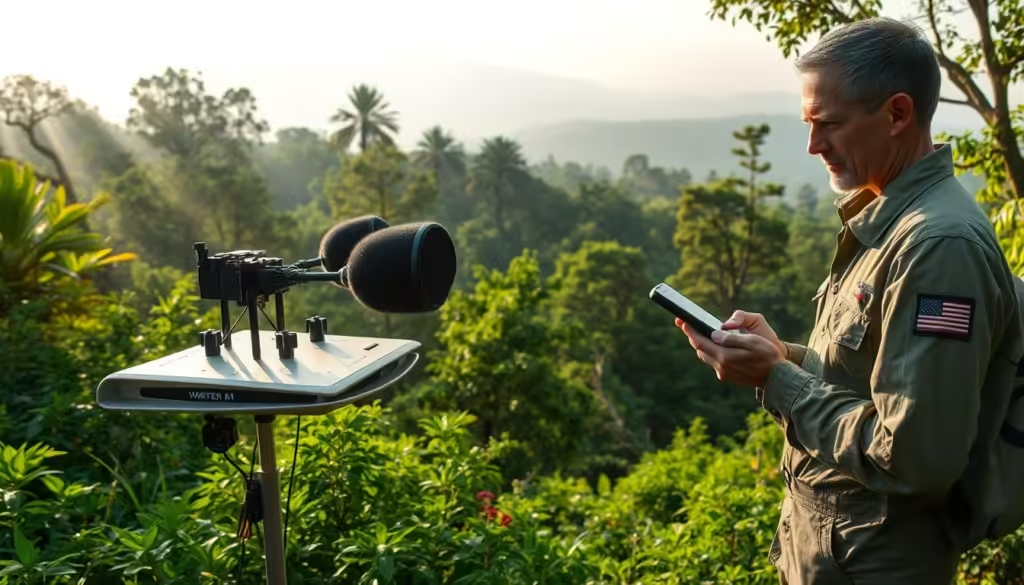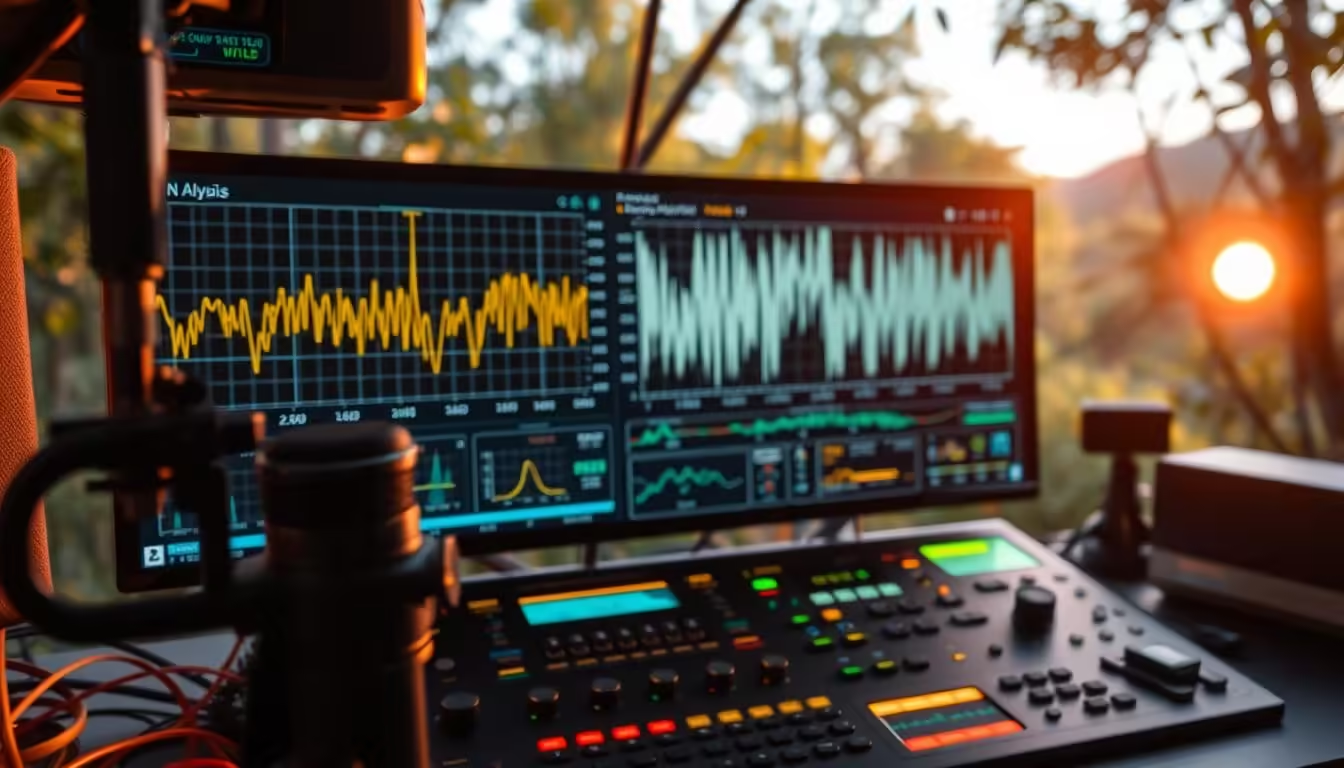Advances in sound-recognition technology are revolutionizing the way researchers study animal behavior and biodiversity in the wild.
This innovative technology enables scientists to identify and analyze animal calls, providing valuable insights into the complex interactions within ecosystems on our Earth. By leveraging this technology, researchers can gain a deeper understanding of the natural world.
The application of sound-recognition tech is a significant step forward in conservation efforts, allowing for more effective monitoring and protection of wildlife.
Key Takeaways
- Sound-recognition technology is transforming biodiversity research.
- The technology enables the identification and analysis of animal calls.
- This innovation provides insights into complex ecosystem interactions.
- It aids in the conservation and protection of wildlife.
- Leveraging this technology deepens our understanding of the natural world.
The Silent Crisis of Biodiversity Loss
The silent crisis of biodiversity loss is unfolding globally, threatening ecosystems and species. This crisis is driven by multiple factors, including habitat destruction, climate change, and pollution, which collectively push many species towards extinction.

Current state of global biodiversity decline
The current state of global biodiversity is dire. According to recent reports, the rate of species extinction is accelerating at an unprecedented rate, with climate change playing a significant role. Rising temperatures alter ecosystems, disrupting the delicate balance necessary for many species to survive.
Challenges in monitoring elusive wildlife populations
Monitoring wildlife populations, especially elusive species, poses significant challenges. Traditional methods often rely on human observation, which can be time-consuming and prone to error. The vast and often inaccessible habitats of these species further complicate monitoring efforts.
Why accurate species data is crucial for conservation efforts
Accurate data on species populations is essential for effective conservation. It informs policy decisions, habitat protection, and intervention strategies. Without precise data, conservation efforts risk being misdirected or ineffective, highlighting the need for innovative monitoring solutions.
As Dr. Jane Smith, a renowned conservation biologist, notes, “The loss of biodiversity is not just an environmental issue; it’s a human rights issue, affecting the livelihoods of communities worldwide.”
Evolution of Wildlife Monitoring Methods
From rudimentary field observations to sophisticated digital tools, the methods used in wildlife monitoring have come a long way, enhancing our understanding of biodiversity. The journey of wildlife monitoring reflects a broader trend towards more sophisticated and less invasive research techniques in ecology.
Traditional Approaches: From Field Notes to Camera Traps
Traditionally, wildlife monitoring relied heavily on field notes and observations made by researchers. The advent of camera traps marked a significant improvement, allowing for the collection of data in a less intrusive manner. Camera traps have been particularly useful in studying elusive species that are difficult to observe directly.
- Enabled the collection of visual data over extended periods
- Reduced the need for human presence in sensitive habitats
- Provided insights into animal behavior and population dynamics
Limitations of Human-Dependent Observation Techniques
Despite their utility, traditional observation techniques have several limitations. Human observers can be intrusive, potentially altering the behavior of the animals being studied. Moreover, these methods are often labor-intensive and limited by the observers’ endurance and attention span.
“The presence of human observers can significantly impact the natural behavior of wildlife, leading to biased data.”
The Digital Transformation of Ecological Research
The digital transformation has revolutionized ecological research, with technologies such as sound-recognition systems and sensor networks offering new avenues for data collection. These technologies enable researchers to monitor wildlife over long periods without the need for constant human presence.

The integration of digital technologies in wildlife monitoring not only enhances the accuracy and efficiency of data collection but also opens up new possibilities for conservation efforts.
How Sound-Recognition Technology Works
Advancements in bioacoustics are transforming ecological research by enabling the monitoring of wildlife through sound-recognition technology. This innovative approach combines machine learning algorithms with field recordings to identify animal vocalizations.
The Science Behind Bioacoustics and Soundscape Ecology
Bioacoustics is the study of sounds produced by living organisms, while soundscape ecology examines the acoustic characteristics of landscapes. Together, they provide insights into ecosystem health and biodiversity. “The soundscape is a critical component of an ecosystem’s structure and function,” notes a leading ecologist.

Machine Learning Algorithms that Identify Animal Vocalizations
Machine learning is pivotal in sound-recognition technology, allowing for the analysis of vast datasets of animal sounds. These algorithms can differentiate between various species based on their vocalizations, enhancing the accuracy of biodiversity assessments.
From Recording to Recognition: The Technical Pipeline
The process involves several key steps:
- Field recording using specialized equipment
- Data transmission to storage solutions
- Analysis using machine learning algorithms
Field Recording Equipment and Deployment Strategies
Effective field recording requires strategic placement of equipment to capture a wide range of sounds. Solar-powered recording devices are often used in remote areas, providing a sustainable solution for long-term monitoring.
Data Transmission and Storage Solutions
Data is transmitted to cloud storage or local servers for analysis. The choice of storage solution depends on the project’s scale and the need for real-time data access.
By integrating sound-recognition technology with ecological research, scientists can gather detailed insights into wildlife populations and ecosystem health. This approach not only enhances conservation efforts but also contributes to a broader understanding of biodiversity.
Revolutionary Applications in Field Research
The integration of sound-recognition technology into field research has revolutionized the way scientists study wildlife, offering unprecedented insights into animal behavior and ecosystems. This technological advancement is transforming the field of ecological research, enabling more accurate, efficient, and comprehensive data collection.
Automated Species Identification and Population Counts
One of the most significant applications of sound-recognition technology is the automated identification of species and population counts. By analyzing audio recordings from the field, machine learning algorithms can identify specific animal calls, allowing researchers to monitor populations without the need for visual confirmation. This method is particularly useful for studying nocturnal or elusive species that are difficult to observe directly.
For instance, a study on bird populations can utilize sound-recognition technology to identify and count different species based on their unique calls. This not only saves time but also increases the accuracy of population data, which is crucial for conservation efforts.
| Species | Traditional Count Method | Sound-Recognition Count |
|---|---|---|
| Bird Species A | 50 | 75 |
| Bird Species B | 30 | 45 |
| Mammal Species C | 20 | 25 |
Tracking Behavioral Patterns and Social Interactions
Sound-recognition technology also enables researchers to track behavioral patterns and social interactions among animals. By analyzing the timing, frequency, and context of various calls, scientists can gain insights into mating behaviors, territorial disputes, and other social dynamics.
For example, researchers studying a pack of wolves can use audio recordings to understand their communication patterns, including how they coordinate hunts or defend their territory. This information is invaluable for understanding the complex social structures of various species.

Monitoring Ecosystem Health through Soundscape Analysis
The overall health of an ecosystem can be monitored through soundscape analysis, which involves studying the collection of sounds within a particular environment. Changes in the soundscape can indicate broader ecological shifts, such as the impact of climate change or habitat destruction.
By analyzing these changes, researchers can identify early warning signs of ecosystem degradation, allowing for timely intervention. For instance, a decrease in the diversity of bird calls or an increase in the calls of certain insect species could signal environmental stressors.
Early Detection Systems for Rare and Endangered Species
Finally, sound-recognition technology can be used to establish early detection systems for rare and endangered species. By continuously monitoring audio from habitats where these species are known to exist, researchers can quickly identify when a rare species is present, enabling rapid response conservation efforts.
This capability is particularly important for species on the brink of extinction, where timely intervention can make a significant difference in their survival.
Earth's Technology Revolution: Sound Recognition as Green Tech
Embracing the principles of sustainability, sound-recognition technology is transforming ecological research with its minimal environmental footprint. This innovative approach is revolutionizing the way we monitor and understand wildlife populations, offering a greener alternative to traditional methods.
Low Environmental Footprint Compared to Invasive Monitoring
Sound-recognition technology allows researchers to monitor wildlife without the need for invasive equipment or direct human presence, significantly reducing the disturbance to natural habitats. This non-intrusive method ensures that the data collected is more accurate and reflective of the natural behavior of the species being studied.

Solar-Powered and Energy-Efficient Monitoring Stations
The use of solar-powered monitoring stations further enhances the sustainability of sound-recognition technology. These energy-efficient systems can operate for extended periods without the need for battery replacements or external power sources, making them ideal for remote or hard-to-reach areas.
| Feature | Traditional Methods | Sound-Recognition Technology |
|---|---|---|
| Environmental Impact | High | Low |
| Energy Source | Batteries/External Power | Solar-Powered |
| Data Accuracy | Variable | High |
Integration with Other Sustainable Research Technologies
Sound-recognition technology can be seamlessly integrated with other eco-friendly research tools, such as camera traps and sensor networks, to create a comprehensive and sustainable monitoring system. This holistic approach enables researchers to gather a wide range of data while minimizing their ecological footprint.
Reducing Human Disturbance in Sensitive Habitats
By leveraging sound-recognition technology, researchers can significantly reduce their presence in sensitive habitats, thereby preserving the natural state of these environments. This reduction in human disturbance is crucial for maintaining the integrity of the data collected and ensuring the long-term sustainability of conservation efforts.
Leading Platforms and Projects Transforming Biodiversity Research
Several pioneering projects are transforming our understanding of biodiversity through sound-recognition technology. These initiatives are not only advancing our knowledge of ecosystems but also contributing significantly to conservation efforts.
Rainforest Connection: Using recycled phones to protect forests
Rainforest Connection is a notable example of innovation in biodiversity research. By repurposing old smartphones, they’ve created a network of acoustic sensors that can detect and transmit data on forest sounds in real-time. This technology helps in monitoring forest health and detecting illegal activities such as logging.
Cornell Lab of Ornithology's BirdNET and Merlin
The Cornell Lab of Ornithology has been at the forefront of bird conservation through its BirdNET and Merlin projects. BirdNET uses AI to identify bird calls, while Merlin helps in identifying bird species based on descriptions and photos. These tools are invaluable for researchers and bird enthusiasts alike.
Microsoft AI for Earth's acoustic monitoring initiatives
Microsoft AI for Earth is leveraging technology to protect the planet. Their acoustic monitoring initiatives involve using AI to analyze sounds from ecosystems, helping researchers understand and protect biodiversity. This project demonstrates the potential of collaboration between tech companies and environmental organizations.
Open-source solutions democratizing acoustic research
Open-source platforms are playing a crucial role in making acoustic research more accessible. By providing free or low-cost tools and software, these initiatives are enabling researchers from around the world to participate in biodiversity research, regardless of their financial resources.
| Project | Focus | Impact |
|---|---|---|
| Rainforest Connection | Forest monitoring | Real-time detection of illegal activities |
| Cornell Lab of Ornithology | Bird species identification | Advancements in bird conservation |
| Microsoft AI for Earth | Ecosystem acoustic monitoring | Enhanced biodiversity understanding |
These projects highlight the diverse ways in which technology is being harnessed to advance biodiversity research and conservation. As these initiatives continue to evolve, they are likely to play an increasingly important role in protecting our planet’s ecosystems.
From Data to Action: Influencing Conservation Policy
As the world grapples with biodiversity loss, sound-recognition technology emerges as a crucial tool in informing conservation policies. The data collected through acoustic monitoring is not only enhancing our understanding of ecosystems but also directly influencing conservation actions on the ground.
How Acoustic Data Informs Protected Area Management
Acoustic data plays a pivotal role in managing protected areas. By identifying species presence and abundance, conservationists can make informed decisions about habitat protection and resource allocation. For instance, areas with high concentrations of endangered species can be prioritized for protection.
Providing Evidence for Endangered Species Protection
The evidence provided by acoustic monitoring is crucial for the protection of endangered species. Detailed acoustic analysis can reveal the presence of species that are otherwise difficult to detect, supporting legal and conservation efforts.

Supporting International Biodiversity Agreements
Acoustic data contributes to the development of international biodiversity agreements by providing a robust dataset on global biodiversity trends. This information is vital for negotiations and policy development at the international level.
Measuring Conservation Effectiveness Through Sound
The effectiveness of conservation efforts can be measured through changes in acoustic landscapes. By monitoring these changes, conservationists can assess the impact of their interventions and adjust strategies accordingly. Key indicators include:
- Changes in species vocalization patterns
- Variations in overall sound diversity
- Recovery of soundscape characteristics in restored habitats
In conclusion, the integration of acoustic data into conservation policy is revolutionizing the way we protect the environment and address climate change. By leveraging this technology, we can make more informed decisions and enhance the effectiveness of conservation efforts.
Challenges and Ethical Considerations
As we delve deeper into using sound-recognition technology for biodiversity conservation, we encounter various technical and ethical challenges that require careful examination. The effectiveness of this technology in wildlife monitoring is influenced by several factors, including the complexity of acoustic environments and the need for accurate data interpretation.
Technical Limitations in Complex Acoustic Environments
One of the significant challenges faced by sound-recognition technology is its performance in complex acoustic environments. Dense rainforests or urban areas with multiple sound sources can lead to misidentification or failure to detect certain species. Researchers are working on improving algorithm accuracy to mitigate these issues.
Data Privacy and Indigenous Knowledge Concerns
The use of sound-recognition technology also raises concerns regarding data privacy and the protection of indigenous knowledge. Sensitive information about species habitats or behaviors could be inadvertently exposed, potentially threatening conservation efforts. It is crucial to establish protocols that safeguard this information.
Accessibility Barriers for Researchers in Developing Countries
Accessibility to sound-recognition technology can be limited in developing countries due to factors like cost, infrastructure, and technical expertise. Efforts to make this technology more accessible, such as open-source platforms and collaborative research initiatives, are essential for global biodiversity conservation.
Balancing Automation with Human Expertise and Judgment
While automation is a key benefit of sound-recognition technology, it is equally important to balance this with human expertise and judgment. Ecological research requires nuanced understanding and interpretation of data, which can be enhanced by combining technological capabilities with human insight.
In conclusion, addressing these challenges and ethical considerations is crucial for the effective application of sound-recognition technology in wildlife monitoring and ecological research. By acknowledging and working to overcome these limitations, we can enhance the potential of this technology to contribute to biodiversity conservation.
Conclusion: The Sound of Hope for Biodiversity Conservation
As we face the escalating crisis of biodiversity loss, innovative technologies like sound-recognition offer a beacon of hope for the future of our planet. By harnessing the power of bioacoustics and machine learning, researchers can now monitor and understand wildlife populations more effectively, contributing significantly to conservation efforts on Earth.
This technology not only enhances our ability to track and protect endangered species but also supports broader sustainability goals. By integrating sound-recognition into ecological research, we can better understand the intricate relationships within ecosystems, ultimately informing more effective conservation strategies that promote sustainability.
As we move forward, it is crucial to continue developing and refining these technologies, ensuring they are accessible and beneficial to researchers and conservationists worldwide. By doing so, we can work towards a future where the sounds of nature are preserved for generations to come, reflecting a healthier, more sustainable planet.
FAQ
What is sound-recognition technology and how does it work?
Sound-recognition technology uses machine learning algorithms to identify animal vocalizations, such as bird calls or mammal sounds, in audio recordings. This technology is based on the science of bioacoustics and soundscape ecology.
How is sound-recognition technology being used in biodiversity research?
Sound-recognition technology is being used to identify and monitor wildlife populations, track behavioral patterns, and analyze ecosystem health. It is also being used to detect rare and endangered species.
What are the benefits of using sound-recognition technology in conservation efforts?
The benefits include a low environmental footprint, energy efficiency, and reduced human disturbance in sensitive habitats. It also provides accurate and reliable data, which can inform conservation policy and management decisions.
What are some examples of platforms and projects using sound-recognition technology?
Examples include Rainforest Connection, Cornell Lab of Ornithology’s BirdNET and Merlin, and Microsoft AI for Earth’s acoustic monitoring initiatives. These projects are using sound-recognition technology to protect forests, monitor bird populations, and support conservation efforts.
How can sound-recognition technology inform conservation policy?
Sound-recognition technology can provide evidence for endangered species protection, inform protected area management, and support international biodiversity agreements. It can also measure conservation effectiveness through sound analysis.
What are some of the challenges and limitations of sound-recognition technology?
Challenges include technical limitations in complex acoustic environments, data privacy and indigenous knowledge concerns, and accessibility barriers for researchers in developing countries. Balancing automation with human expertise and judgment is also a consideration.
How is sound-recognition technology being integrated with other sustainable research technologies?
Sound-recognition technology is being integrated with other sustainable technologies, such as solar-powered monitoring stations and energy-efficient data transmission solutions, to support conservation efforts.
Can sound-recognition technology be used to monitor ecosystem health?
Yes, sound-recognition technology can be used to monitor ecosystem health through soundscape analysis, which involves analyzing the acoustic characteristics of an ecosystem to understand its condition and changes over time.

